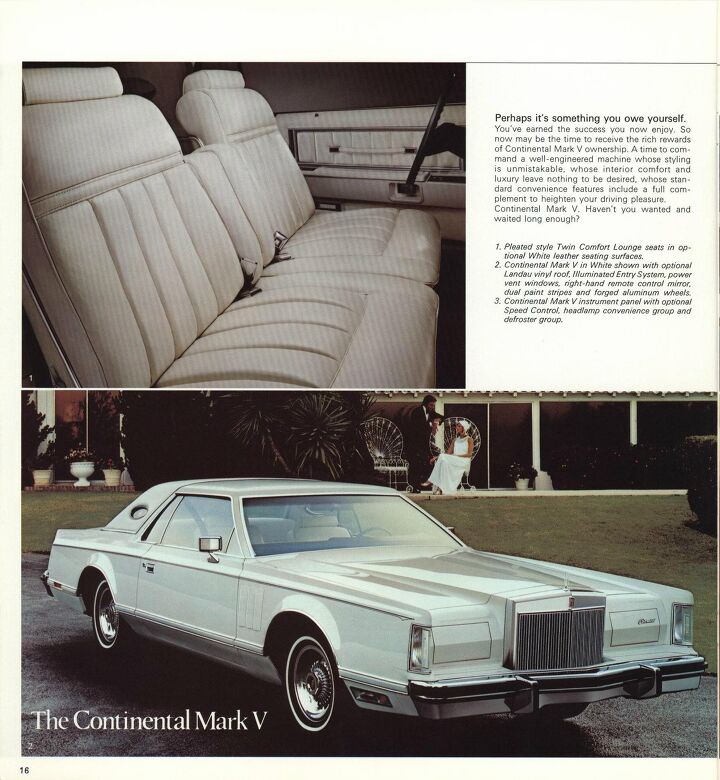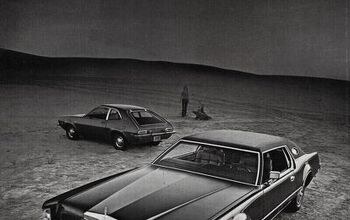Rare Rides Icons: The Lincoln Mark Series Cars, Feeling Continental (Part XXVII)

Making our way through the trim-laden legacy of the Lincoln Continental Mark V has consumed all of our attention over the past few weeks. After spending some time on the mid-tier Luxury Group packages of 1977 to 1979, we pored over the Designer Series editions of 1977 and 1978. The latter of those two years was Ford’s 75th anniversary and saw the launch of the super expensive Diamond Jubilee package to celebrate. For the Mark V’s outgoing year in 1979, the Designer Series cars returned, and Lincoln reworked the Diamond Jubilee package into the Collector’s Series. It’s time to have one final Mark V trim talk.
The Bill Blass Designer Series went two-tone with its exterior in ‘79, a first for the trim. The upper half of the Blass was painted in non-metallic White, while the lower half was Midnight Blue Metallic (“Moondust” in Lincoln speak). The blue was a slightly different shade than used in 1977; a non-metallic finish. The standard vinyl roof of 1979 was offered in two configurations, which used two different vinyl grains - another first.
Both roof treatments were in White, with one new style exclusive among the Designer Series to Blass. Called the Carriage Roof, the full vinyl covering deleted the opera window and added a Bill Blass logo, as well as ribbed detailing along the roof for a simulated convertible look. The Carriage option was fitted with Diamond grain vinyl.
The other roof option was the full vinyl roof from prior years, covered in the same Valino grain as offered in 1977. Per photos available on the Internet, the new Carriage Roof was the far more popular choice that year. Interiors on the ‘79 Bill Blass were the most nautical ever, fitted in White leather with Midnight Blue straps and trim, or a reverse of the color scheme where Midnight Blue was the dominant color.
There were fewer changes at Cartier for 1979, where the same Light Champagne non-metallic finish remained the only paint available. The Cartier’s roof was again Light Champagne Valino grain, though was only offered in Landau configuration (no full vinyl in ‘79). To distinguish the Cartier from prior years, there were new Dark Red moldings that wrapped over the roof, along with new standard opera lamps.
The interior of the Cartier was exactly the same as 1978, in Champagne with Dark Red accents, available in either leather or Media Velour. Of all the Designer Editions, Cartier received the least good-faith effort to differentiate 1978 from 1979. There’s no word on whether that was Cartier’s choice or Lincoln’s decision.
The Givenchy edition of 1979 went in a totally different direction from its prior two years in color. Green went by the wayside and was replaced by Crystal Blue Metallic (not quite the same shade as the ‘78 Diamond Jubilee). For the first time, the Givenchy had a color-matched roof, in Crystal Blue Valino grain vinyl. It was available only in a front-half configuration, as before.
Inside, the seat pattern unique to the Givenchy of 1978 continued, with leather seating surfaces and a horizontal strap of embroidered broad lace that wore a repeated Givenchy G logo. This time the color theme was Dark Crystal Blue, an interior color not shared with any other Designer Series. The Givenchy G was also repeated on the exterior as part of the pinstriping and made it perhaps the most vulgar of the Designer Series cars in 1979.
Finally, the Pucci edition of 1979 was the boldest color option available of any Mark V Designer Series. After Black and Light Silver Metallic, the Pucci switched things up with Medium Turquoise Metallic. The only roof layout was a full vinyl covering in Valino grain, finished in a striking Midnight Blue (another new color). The Pucci edition went with a two-tone interior, but its color combo was the same as one of two Bill Blass options that year: White leather with Midnight Blue accents and trim was the only choice.
1979 wasn’t a special birthday for Ford, but it was the end of the traditional full-size car at Ford and Lincoln. To commemorate the end, Lincoln created the Collector’s Series for 1979. The package was a repurposing of the Diamond Jubilee Edition of the prior year and contained the same higher-quality trim and special features. However, unlike the Diamond Jubilee the Collector’s Series did not receive its own unique paint colors.
It seemed Lincoln was very pleased with the Bill Blass colors that year, both its Midnight Blue Metallic and White paint were used for the Collector’s Series cars. Collector’s Series was also available in the Diamond Blue Metallic of the extinct Diamond Jubilee, and Light Silver Metallic that returned from the 1978 Pucci. Worth noting, both Diamond Blue and Light Silver were mid-79 additions and were much more limited in production.
Blue and White examples of the Collector’s Series had monochromatic exteriors, with matching vinyl roof treatments. The Diamond Blue and Light Silver cars had contrasting Midnight Blue tops shared with the 1979 Pucci. However, the vinyl arrangement was unique to the Collector’s Series: A Landau style, it included the opera lamps of the Cartier but deleted the opera window. In its place was a large gold “Collector’s Series” script badge.
Other trim details were a carryover from the Diamond Jubilee, like additional interior wood, luxurious carpeting, and gold grille veins and hood ornaments. All examples were fitted with a Midnight Blue dash and carpet, regardless of exterior paint and leather color. Subjectively, this interior color scheme worked least well on those painted Light Silver.
There were slightly more Collector’s Series cars sold than the Diamond Jubilee, as customers saw it as their final opportunity to buy a land yacht. Remember that Ford was the last of the Detroit manufacturers to offer truly full-sized cars, as the others had already downsized. Of 6,262 Collector’s Series Mark Vs, 3,900 were Midnight Blue, and 2,040 were White. Much rarer, there were only 197 Diamond Blue cars and 125 in Light Silver.
Like the Diamond Jubilee, customers paid dearly for a Collector’s Series, at $8,000 ($34,763 adj.) over the $13,067 ($56,782 adj.) price of the standard car, for a grand total of $21,067 ($91,546 adj.). Likewise, they ponied up for the special Carriage Roof Bill Blass, which was $2,775 ($12,058 adj.), versus $1,809 ($7,860 adj.) for a full vinyl Blass.
Cartier asked $1,945 ($8,451 adj.) in leather or velour in its final outing, while Givenchy with its more prestigious looks was $2,145 ($9,321 adj.). And finally, the daring Pucci was the least costly of them all at $1,545 ($6,713 adj.).
And though 1979 was the end of the Mark V, we’re not quite finished with it. In our final entry on the largest Mark coupe ever made, we’ll discuss annual production figures as well as the yearly changes Lincoln made to its halo coupe.
[Images: Ford]
Become a TTAC insider. Get the latest news, features, TTAC takes, and everything else that gets to the truth about cars first by subscribing to our newsletter.

Interested in lots of cars and their various historical contexts. Started writing articles for TTAC in late 2016, when my first posts were QOTDs. From there I started a few new series like Rare Rides, Buy/Drive/Burn, Abandoned History, and most recently Rare Rides Icons. Operating from a home base in Cincinnati, Ohio, a relative auto journalist dead zone. Many of my articles are prompted by something I'll see on social media that sparks my interest and causes me to research. Finding articles and information from the early days of the internet and beyond that covers the little details lost to time: trim packages, color and wheel choices, interior fabrics. Beyond those, I'm fascinated by automotive industry experiments, both failures and successes. Lately I've taken an interest in AI, and generating "what if" type images for car models long dead. Reincarnating a modern Toyota Paseo, Lincoln Mark IX, or Isuzu Trooper through a text prompt is fun. Fun to post them on Twitter too, and watch people overreact. To that end, the social media I use most is Twitter, @CoreyLewis86. I also contribute pieces for Forbes Wheels and Forbes Home.
More by Corey Lewis
Latest Car Reviews
Read moreLatest Product Reviews
Read moreRecent Comments
- Bd2 I hope Elon eats one for dinner.
- Wjtinfwb I really like these, but can't shake the voice in my head that says, "$9000 will just be the starting point. You'll have 20 grand in this baby inside of 18 months".
- SCE to AUX I hope they're buying good lawyers, too.
- SCE to AUX Nothing to see here. Gas prices 2021-23 were the same as they were in 2007-2008, adjusted for inflation. The R's were in charge then.https://www.randomuseless.info/gasprice/gasprice.html
- VoGhost Just reminding us all that we have to tolerate dealers (many of whom are billionaires) in the US if we want new legacy ICE vehicles because the dealers pay for the campaigns of local politicians, with our money.













































Comments
Join the conversation
Corey, in regards to the final entry in this series in which "we’ll discuss annual production figures as well as the yearly changes Lincoln made to its halo coupe". Might I suggest the following either in the article or adding another article to the series?
The Marks are often overlooked for their influence on the domestic automotive industry. From the mid 1960's until their introduction, despite being driven by Oliver Wendell Douglas, Lincoln was far behind Cadillac in prestige, sales and public perception. Without checking statistics, I would assume that Chrysler sales exceeded those of Lincolns. The Marks changed that. And the Town Car would also benefit from this 'halo' effect. The 1970's might have been Lincoln's decade.
PLC's which are now almost 'extinct' were the 1970's version of this era's SUVs. People aspired to them. They sold in record numbers. And the Mark III, IV and V were the ultimate expression of the PLC.
The Mark III and IV also were the ultimate expression of 'brougham'. Opera windows, coach lights, hideaway headlights, 'majestic' velour interiors in pastel colours, and massive chrome grilles. Other vehicles may have had some of these prior to the Marks but none embraced all of them and expressed them in the same manner. Even the 'continental hump' which some added to their Town Cars and as an after market accessory installed on many PLCs, Cadillacs and even VW Beetles.
Finally as above, 'broughaming' a vehicle replaced improved engineering. Size, weight, chrome, 'luxury accessories', and cubic inches were marketed rather than performance or engineering. Hence the creation of the 'Malaise Era'. And unfortunately the influence of the Marks on public perception and their sales figures (and asking price/mark-up) had a significant impact on auto manufacturers focusing on 'style over substance'.
Never understood the fake convertible roof feature. It's a bit obvious there's no convertible roof.